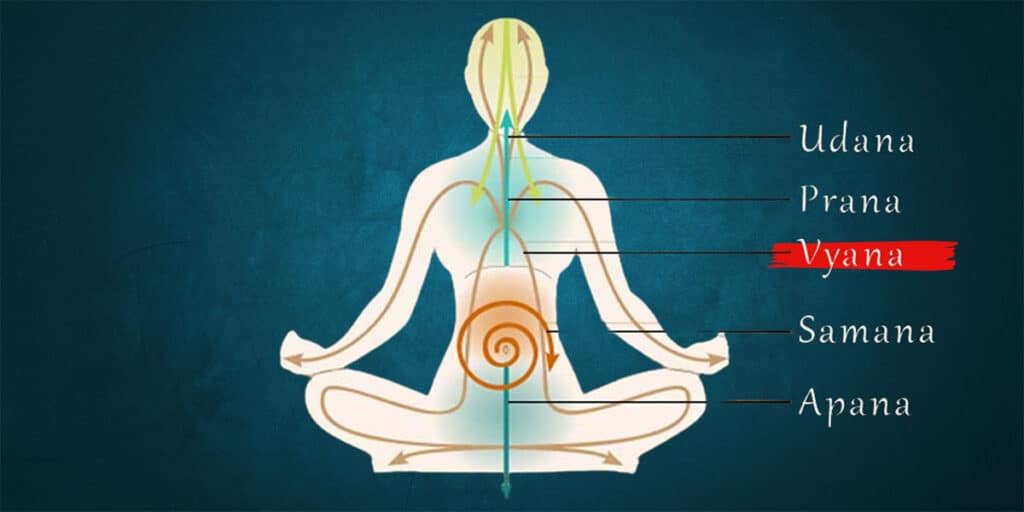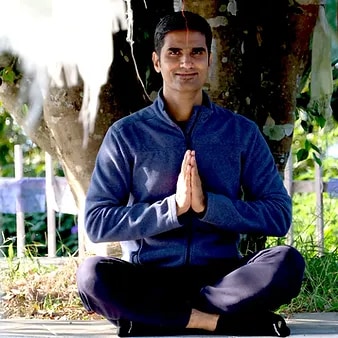Understanding Vyana Vayu – The Fifth Panch Prana and Its Role in Yogic Living
by Hardik Mehta

In the realm of yogic science and Ayurveda, the human body is not merely a mechanical structure but an intricate energy system guided by prana, the life force. Among the various layers of pranic energy in the body, the five Panch Pranas are of utmost importance. The five essential life forces—Prana, Apana, Samana, Udana, and Vyana—each play a unique role in managing the body’s physical and energetic processes. This blog focuses on the fifth and final Panch Prana: Vyana Vayu, its significance, how to balance it, and why it holds the key to holistic wellness and spiritual awareness.
What is Vyana Vayu?
Derived from the Sanskrit word Vyana, meaning “diffusing” or “pervasive,” Vyana Vayu is the vital life force that circulates energy throughout the body. While the other Pranas are localised in certain regions (Prana in the chest, Apana in the pelvic area, etc.), Vyana pervades the entire body.
It acts as the force behind circulation, responsible for the movement of blood, lymph, and even thoughts. Vyana ensures that the energy from food, breath, and experiences is evenly distributed to every cell. It connects and supports the functioning of all other pranas, thus earning the name “the integrator.”
Location and Movement of Vyana Vayu
Vyana Vayu operates from the heart and moves throughout the body, extending to the skin and limbs. Its direction is outward and expansive, creating an electromagnetic field that links the physical body to the energetic body. If Prana Vayu brings energy in, Vyana Vayu is the one that spreads it everywhere.
It governs:
- Circulation of blood
- Transmission of nerve impulses
- Movement of joints and limbs
- Coordination of muscles
- Expansion and contraction processes
- Balance and posture
The Importance of Vyana Vayu in Daily Life
When Vyana Vayu is in harmony, pranic energy circulates effortlessly across the entire body, promoting smooth movement, physical coordination, vibrant energy levels, and a clear, focused mind. However, any disruption in its rhythm may lead to a range of physical ailments and emotional disturbances.
Signs of Imbalanced Vyana Vayu:
- Poor blood circulation
- Numbness or tingling sensations
- Muscular stiffness or tremors
- Uncoordinated body movements
- Anxiety or erratic mental states
Even with a nutritious diet, the body may struggle to absorb and utilise essential nutrients effectively.
Since Vyana is connected to every movement—voluntary and involuntary—its dysfunction can manifest in both physical and mental blocks.
How to Balance and Awaken Vyana Vayu
Yoga offers a multidimensional approach to activating and balancing Vyana Vayu. Since it supports all other pranas, working on Vyana Vayu brings a deep sense of integration within the body and mind.
- Asana (Yoga Postures)
Dynamic postures that enhance circulation and coordination are ideal. These include:
- Vinyasa Flow
- Surya Namaskar (Sun Salutations)
- Trikonasana (Triangle Pose)
- Virabhadrasana Series (Warrior Poses)
- Dhanurasana (Bow Pose)
These postures stretch the body while strengthening the heart and muscles, improving circulation and pranic flow.
- Pranayama (Breath Control)
Breathwork practices like Pranayama play a vital role in stimulating and harmonising Vyana Vayu’s expansive energy.
- Nadi Shodhana (Alternate Nostril Breathing) – Encourages balanced energy circulation and supports full-body pranic integration.
- Bhastrika (Bellows Breath) – Increases circulation and awakens sluggish prana.
- Meditation and Dharana (Concentration)
Meditative practices that bring awareness to the whole body can deeply activate Vyana Vayu. Try:
- Body Scan Meditation – Bringing attention to each part of the body helps move energy.
- Mantra Meditation – The vibrational field of sound helps expand pranic flow outward.
- Mudras and Bandhas
- Hridaya Mudra (Heart Gesture) – Enhances emotional balance and circulatory function.
- Mula Bandha (Root Lock) and Uddiyana Bandha (Abdominal Lock) – Encourage upward and outward pranic movement.
The Spiritual Dimension of Vyana Vayu
Beyond physical circulation, Vyana Vayu plays a role in connecting the koshas—the five sheaths of existence (physical, energetic, mental, wisdom, and bliss bodies). When balanced, it leads to:
- Unified body-mind awareness
- Deep states of meditation
- Balanced energy channels (nadis)
- Enhanced intuition and self-realisation
Vyana is the bridge between the inner and outer world. As practitioners deepen their awareness of this Vayu, they begin to experience wholeness, integration, and expansion—not just physically, but spiritually.
Daily Practices to Enhance Vyana Vayu
- Start your day with warm water and light movement to awaken circulation.
- Practice yoga asanas and breathwork regularly to prevent stagnation.
- Avoid a sedentary lifestyle – movement keeps Vyana healthy.
- Practice gratitude and open-hearted living – the heart is the seat of Vyana.
- Gently invigorate your energy pathways through daily self-massage (Abhyanga) using warm, nourishing oils to awaken circulation and promote inner vitality.
Vyana Vayu and Holistic Health
When Vyana is functioning optimally, every system—circulatory, nervous, muscular, and endocrine—works in sync. You feel alive, active, and aware. Your emotions are balanced, and your connection to life becomes more joyful.
Imbalances, on the other hand, can cause a ripple effect on the other pranas, leading to physical disease, emotional instability, or even spiritual disconnect. Therefore, cultivating and harmonising Vyana Vayu is vital for achieving total physical, mental, and energetic balance.
Learn the Secrets of Vyana Vayu at Sayujya Yoga
At Sayujya Yoga, we offer a deep and structured exploration of the Panch Pranas, including Vyana Vayu, in our 200-Hour Yoga Teacher Training Course (TTC). Designed by expert teachers with traditional knowledge and modern scientific backing, the course provides a powerful foundation in:
- Yoga Philosophy
- Asanas, Pranayama & Bandhas
- Anatomy & Physiology
- Meditation & Mindfulness
- Panch Prana Theory & Applications
Located in the heart of Mumbai, Sayujya Yoga is one of the best yoga institutes in India, known for its authentic teachings, small class sizes, personalized guidance, and life-changing approach.
Whether you’re a beginner or aspiring teacher, our 200-hour TTC will give you a transformative experience to not just teach yoga, but live it.
About the Author

Hardik Mehta
Hardik is an E-RYT 500 & YACEP (Yoga Alliance Continuing Education Provider), Yoga Alliance, USA. He has been practicing yoga for the last 9 years. Prior to finding his true calling in Yoga, he was working with various corporates for 12 years in the Retail and eCommerce sector.
